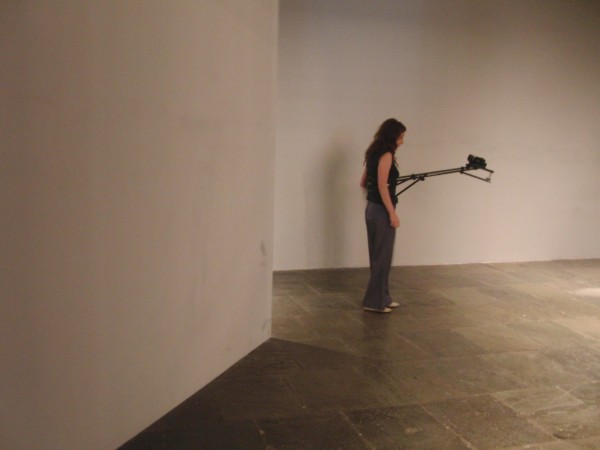Whitney Museum of American Art
945 Madison Ave. at 75th St.
Wednesday – Sunday through October 9
Admission: $12-$18 (pay-what-you-wish Fridays from 6:00 to 9:00)
212-570-3600
www.whitney.org
www.xaviercha.com
Xavier Cha blurs the line between performer and audience, live and recorded action, and public and private space, calling into question what is being witnessed in her multimedia installation “Body Drama.” Every hour on the hour beginning at 12 noon on Wednesday, Thursday, Saturday, and Sunday and 3:00 on Friday, one of eleven actors straps on a specially made body-mounted camera that extends in front of them, focused on their face. For twenty minutes, the performer wanders around the Anne and Joel Ehrenkranz Gallery, acting as if they are seeing something terrible. The all-white space is empty save for a diagonal wall cutting across one side, dividing the location in an uneven, off-balance way. The actor can writhe on the floor, twist slowly along the walls, get trapped in the corners, all the while looking terrified. During the performance, visitors are allowed to move within the gallery, watching but not actually interacting. It’s a disconcerting experience, looking at a person frightened by something that you can’t see even though you are in the same general area. It also breaks down the usual barrier between the performer onstage and the audience in their seats, making the viewer’s emotional and physical involvement that much more palpable. After the actor leaves the gallery, a carefully edited video of a previous performance is screened on the diagonal wall, but in this case only the face is visible, offering a completely different perspective on the fear that overtakes the performers and confounds the viewer, becoming even more visceral. In some ways, it even makes the viewer feel responsible, as if maybe they could have saved the terrified performer, but after having done nothing is forced to watch the results of their inaction. Born in Los Angeles in 1980 and based in New York City, Cha has challenged the expectations of the viewer amid unusual spaces in such previous works as “Topiary Tags,” “Looking Glass,” “Two-Way Mirror,” and “Portal”; in “Body Drama,” she once again confronts the audience, forcing them to question both what they are seeing and what they are feeling, resulting in a complex, captivating experience. (Also at the Whitney right now is the splendid “Lyonel Feininger: At the Edge of the World,” the innovative “Cory Arcangel: Pro Tools,” and the fascinating “More Than That: Films by Kevin Jerome Everson.”)
